Abstract
1. The effects of extracellular adenosine 5'-triphosphate ([ATP]zero) on the L-type Ca2+ channel currents in guinea-pig single sinoatrial nodal (SAN) cells, isolated by enzymatic dissociation, were investigated by use of whole-cell patch-clamp techniques. 2. The application of [ATP]zero (2 microM-1 mM) produced an inhibitory effect on the L-type Ca2+ channel current peak amplitude (10 mM Ba2+ as charge carrier) in a concentration-dependent and reversible manner with an IC50 of 100 microM and a Hill coefficient of 1.83. 3. The presence of the adenosine receptor antagonists, 8-cyclopentyl-1,3-dipropylxanthine (DPCPX, 0.1 microM) and 8-phenyltheophylline (10 microM) did not affect the [ATP]zero-induced inhibition of the Ca2+ channel currents. Adenosine (100 microM) had little effect on the basal Ca2+ channel currents. Adenosine 500 microM, caused 23% inhibition of the Ca2+ channel current, which was abolished by 0.1 microM DPCPX. 4. The presence of the P2-purinoceptor antagonists, suramin (1, 10 and 100 microM), reactive blue 2 (1 and 10 microM) and pyridoxal-phosphate-6-azophenyl-2',4'-disulphonic acid (PPADS, 50 and 100 microM) failed to affect the inhibitory action of [ATP]zero on Ca2+ channel currents. 5. The relative rank order of potency of different nucleotides and nucleosides, at a concentration of 100 microM, on the inhibition of the Ca2+ channel currents is as follows: adenosine 5'-triphosphate (ATP) = alpha,beta-methylene-ATP (alpha,beta MeATP) > > 2-methylthioATP (2-MeSATP) > or = adenosine 5'-O-(3-thiotriphosphate) (ATP gamma S) > > uridine 5'-triphosphate (UTP) = adenosine 5'-diphosphate (ADP) > adenosine 5'-monophosphate (AMP) > or = adenosine. 6. These results suggest that [ATP]zero may play an important role in the heart beat by inhibiting the L-type Ca2+ channel currents in single SAN cells. This inhibitory effect is not due to the formation of adenosine resulting from the enzymatic degradation of [ATP]zero. Based on the relative order of inhibitory potency of different nucleotides and nucleosides on the L-type Ca2+ channel currents and the ineffectiveness of the purinoceptor antagonists tested, a novel type of purinoceptor may be involved.
Full text
PDF
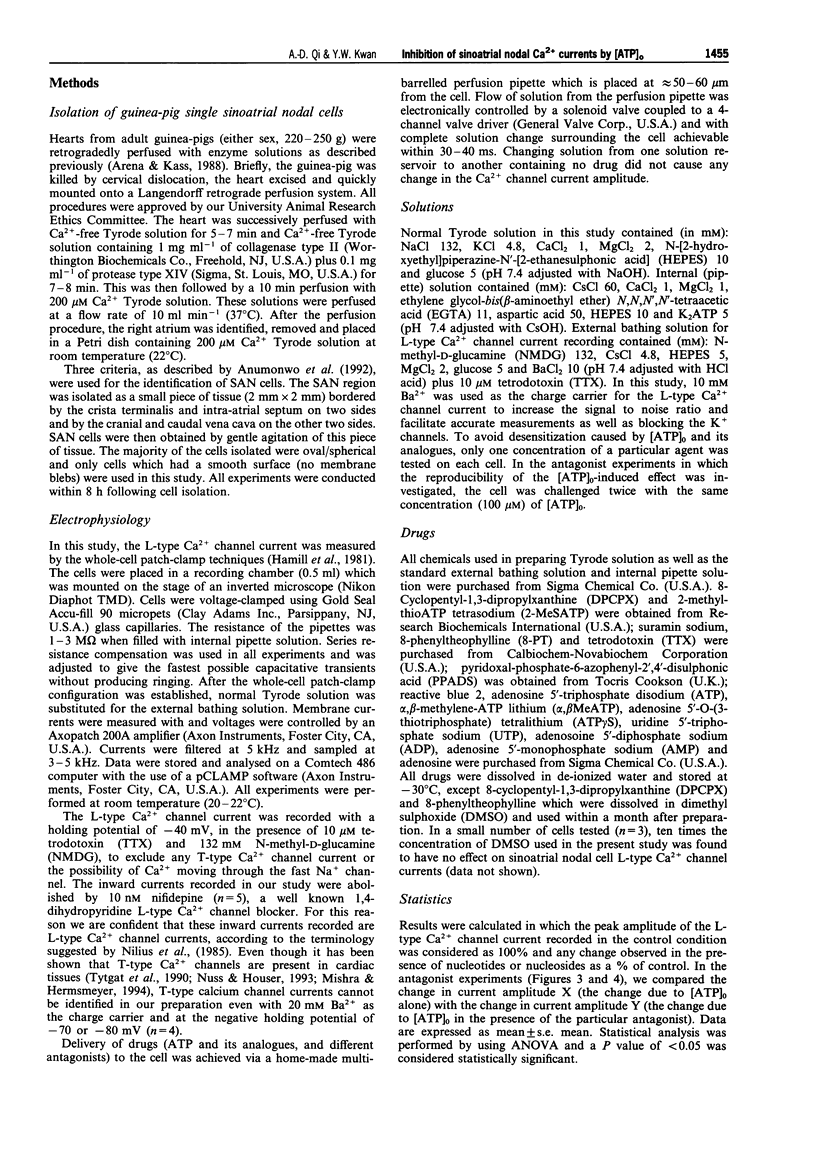
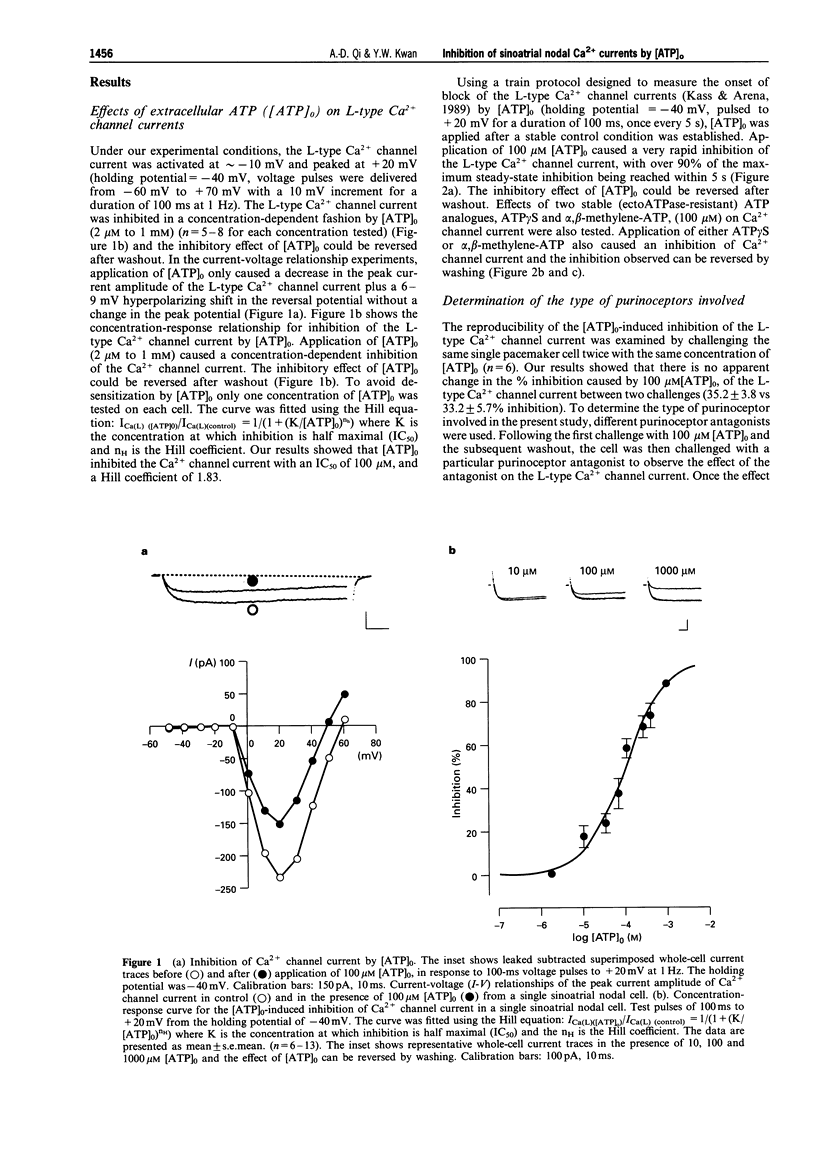

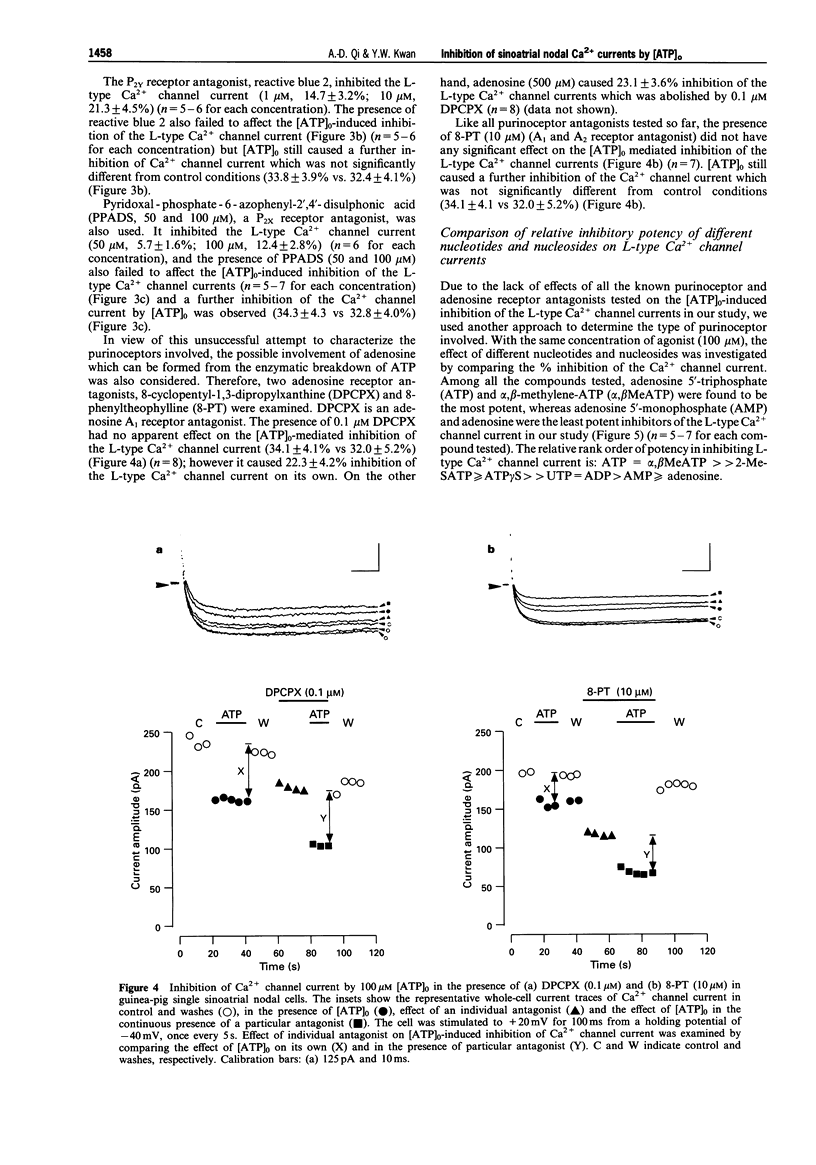
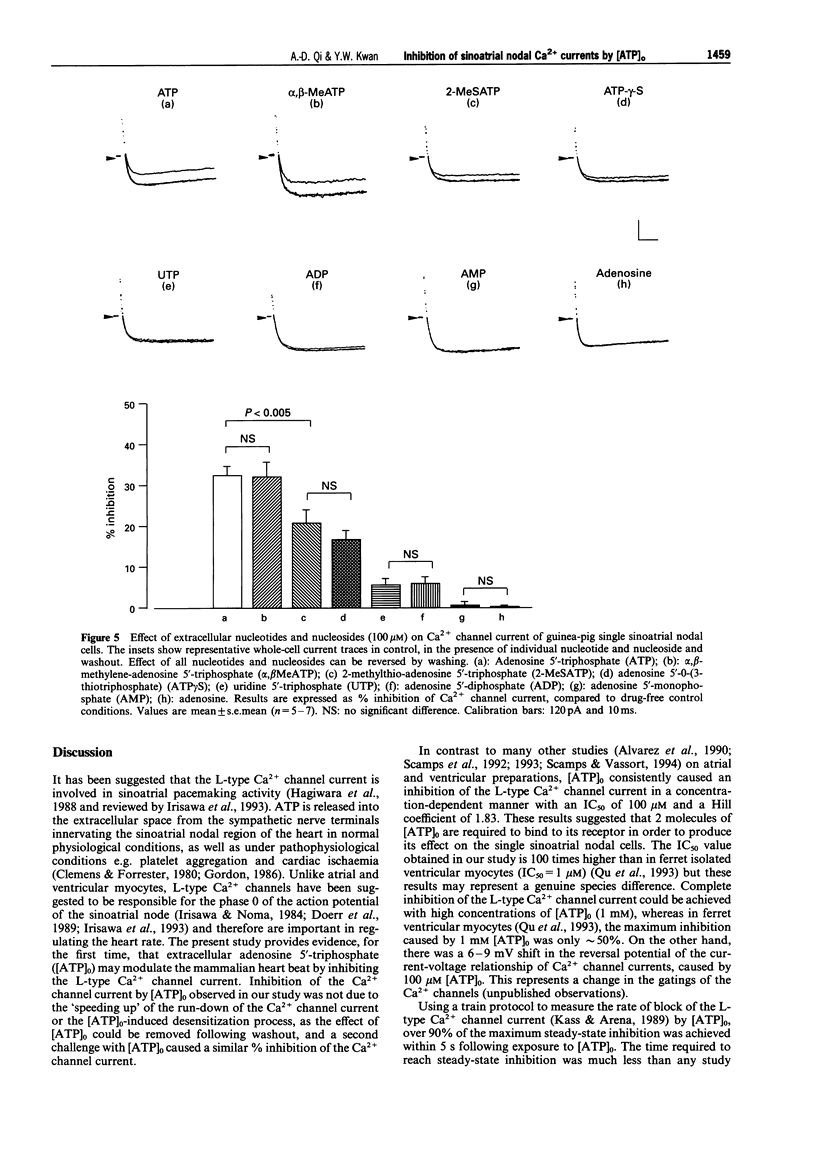
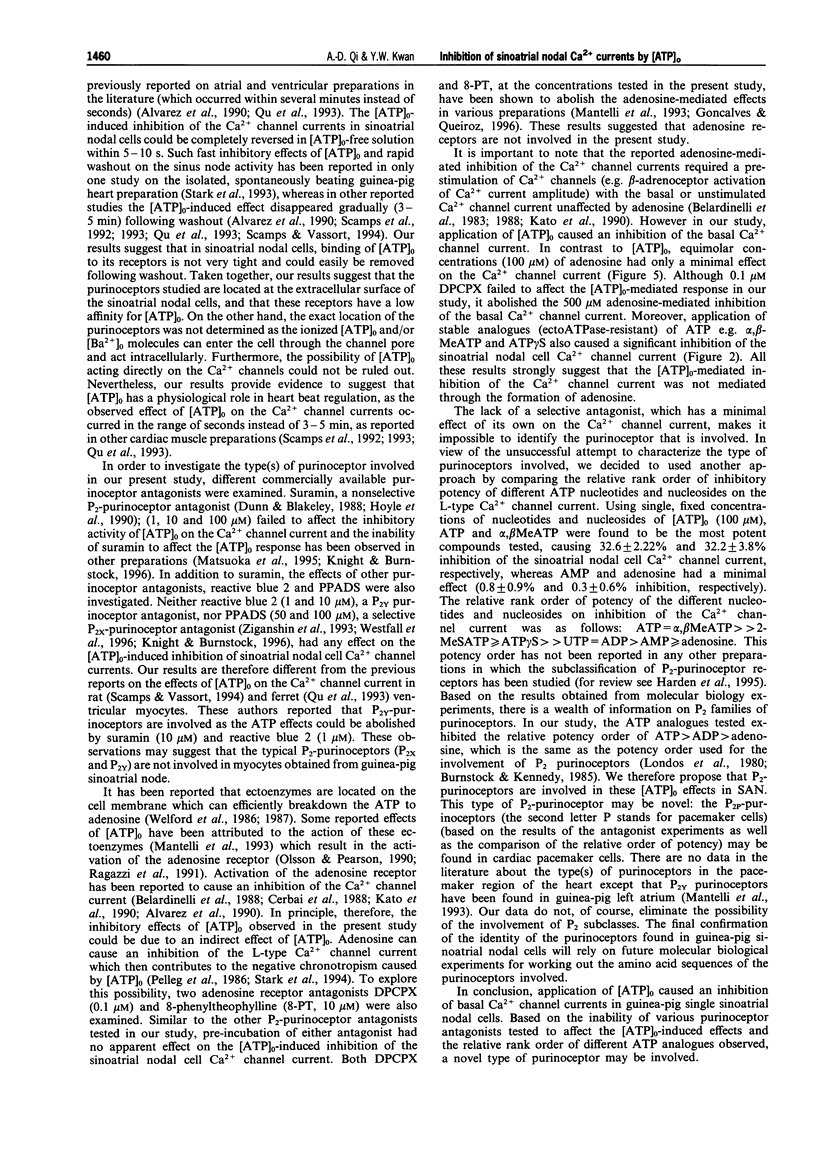
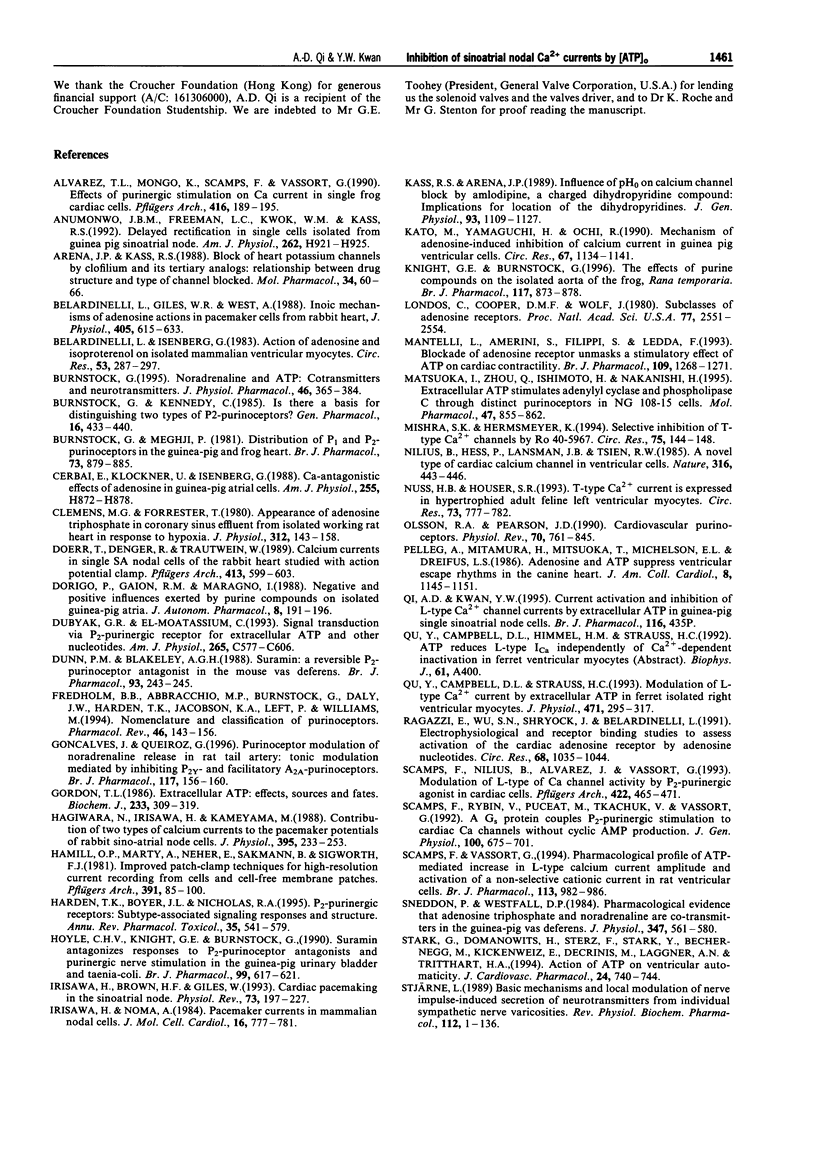
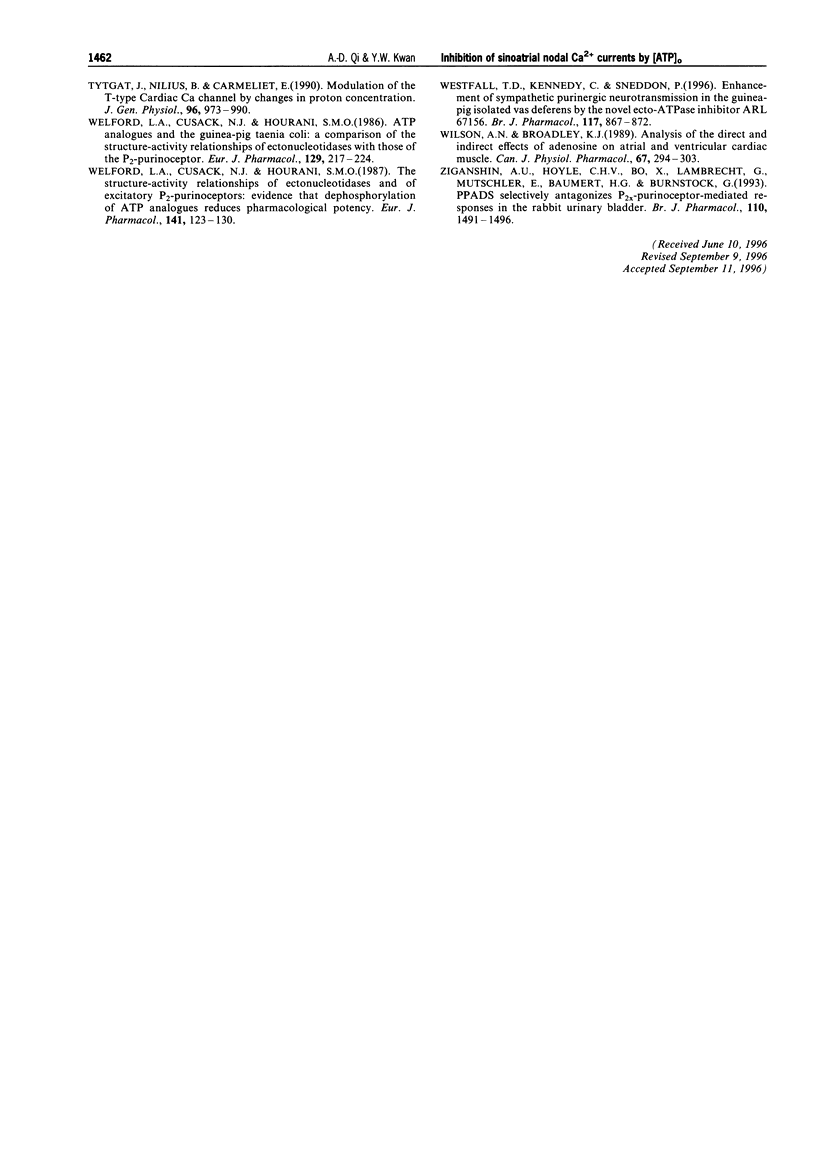
Selected References
These references are in PubMed. This may not be the complete list of references from this article.
- Alvarez J. L., Mongo K., Scamps F., Vassort G. Effects of purinergic stimulation on the Ca current in single frog cardiac cells. Pflugers Arch. 1990 Apr;416(1-2):189–195. doi: 10.1007/BF00370241. [DOI] [PubMed] [Google Scholar]
- Anumonwo J. M., Freeman L. C., Kwok W. M., Kass R. S. Delayed rectification in single cells isolated from guinea pig sinoatrial node. Am J Physiol. 1992 Mar;262(3 Pt 2):H921–H925. doi: 10.1152/ajpheart.1992.262.3.H921. [DOI] [PubMed] [Google Scholar]
- Arena J. P., Kass R. S. Block of heart potassium channels by clofilium and its tertiary analogs: relationship between drug structure and type of channel blocked. Mol Pharmacol. 1988 Jul;34(1):60–66. [PubMed] [Google Scholar]
- Belardinelli L., Giles W. R., West A. Ionic mechanisms of adenosine actions in pacemaker cells from rabbit heart. J Physiol. 1988 Nov;405:615–633. doi: 10.1113/jphysiol.1988.sp017352. [DOI] [PMC free article] [PubMed] [Google Scholar]
- Belardinelli L., Isenberg G. Actions of adenosine and isoproterenol on isolated mammalian ventricular myocytes. Circ Res. 1983 Sep;53(3):287–297. doi: 10.1161/01.res.53.3.287. [DOI] [PubMed] [Google Scholar]
- Burnstock G., Kennedy C. Is there a basis for distinguishing two types of P2-purinoceptor? Gen Pharmacol. 1985;16(5):433–440. doi: 10.1016/0306-3623(85)90001-1. [DOI] [PubMed] [Google Scholar]
- Burnstock G., Meghji P. Distribution of P1- and P2-purinoceptors in the guinea-pig and frog heart. Br J Pharmacol. 1981 Aug;73(4):879–885. doi: 10.1111/j.1476-5381.1981.tb08741.x. [DOI] [PMC free article] [PubMed] [Google Scholar]
- Burnstock G. Noradrenaline and ATP: cotransmitters and neuromodulators. J Physiol Pharmacol. 1995 Dec;46(4):365–384. [PubMed] [Google Scholar]
- Cerbai E., Klöckner U., Isenberg G. Ca-antagonistic effects of adenosine in guinea pig atrial cells. Am J Physiol. 1988 Oct;255(4 Pt 2):H872–H878. doi: 10.1152/ajpheart.1988.255.4.H872. [DOI] [PubMed] [Google Scholar]
- Clemens M. G., Forrester T. Appearance of adenosine triphosphate in the coronary sinus effluent from isolated working rat heart in response to hypoxia. J Physiol. 1981 Mar;312:143–158. doi: 10.1113/jphysiol.1981.sp013621. [DOI] [PMC free article] [PubMed] [Google Scholar]
- Doerr T., Denger R., Trautwein W. Calcium currents in single SA nodal cells of the rabbit heart studied with action potential clamp. Pflugers Arch. 1989 Apr;413(6):599–603. doi: 10.1007/BF00581808. [DOI] [PubMed] [Google Scholar]
- Dorigo P., Gaion R. M., Maragno I. Negative and positive influences exerted by purine compounds on isolated guinea-pig atria. J Auton Pharmacol. 1988 Sep;8(3):191–196. doi: 10.1111/j.1474-8673.1988.tb00182.x. [DOI] [PubMed] [Google Scholar]
- Dubyak G. R., el-Moatassim C. Signal transduction via P2-purinergic receptors for extracellular ATP and other nucleotides. Am J Physiol. 1993 Sep;265(3 Pt 1):C577–C606. doi: 10.1152/ajpcell.1993.265.3.C577. [DOI] [PubMed] [Google Scholar]
- Dunn P. M., Blakeley A. G. Suramin: a reversible P2-purinoceptor antagonist in the mouse vas deferens. Br J Pharmacol. 1988 Feb;93(2):243–245. doi: 10.1111/j.1476-5381.1988.tb11427.x. [DOI] [PMC free article] [PubMed] [Google Scholar]
- Fredholm B. B., Abbracchio M. P., Burnstock G., Daly J. W., Harden T. K., Jacobson K. A., Leff P., Williams M. Nomenclature and classification of purinoceptors. Pharmacol Rev. 1994 Jun;46(2):143–156. [PMC free article] [PubMed] [Google Scholar]
- Gonçalves J., Queiroz G. Purinoceptor modulation of noradrenaline release in rat tail artery: tonic modulation mediated by inhibitory P2Y- and facilitatory A2A-purinoceptors. Br J Pharmacol. 1996 Jan;117(1):156–160. doi: 10.1111/j.1476-5381.1996.tb15168.x. [DOI] [PMC free article] [PubMed] [Google Scholar]
- Gordon J. L. Extracellular ATP: effects, sources and fate. Biochem J. 1986 Jan 15;233(2):309–319. doi: 10.1042/bj2330309. [DOI] [PMC free article] [PubMed] [Google Scholar]
- Hagiwara N., Irisawa H., Kameyama M. Contribution of two types of calcium currents to the pacemaker potentials of rabbit sino-atrial node cells. J Physiol. 1988 Jan;395:233–253. doi: 10.1113/jphysiol.1988.sp016916. [DOI] [PMC free article] [PubMed] [Google Scholar]
- Hamill O. P., Marty A., Neher E., Sakmann B., Sigworth F. J. Improved patch-clamp techniques for high-resolution current recording from cells and cell-free membrane patches. Pflugers Arch. 1981 Aug;391(2):85–100. doi: 10.1007/BF00656997. [DOI] [PubMed] [Google Scholar]
- Harden T. K., Boyer J. L., Nicholas R. A. P2-purinergic receptors: subtype-associated signaling responses and structure. Annu Rev Pharmacol Toxicol. 1995;35:541–579. doi: 10.1146/annurev.pa.35.040195.002545. [DOI] [PubMed] [Google Scholar]
- Hoyle C. H., Knight G. E., Burnstock G. Suramin antagonizes responses to P2-purinoceptor agonists and purinergic nerve stimulation in the guinea-pig urinary bladder and taenia coli. Br J Pharmacol. 1990 Mar;99(3):617–621. doi: 10.1111/j.1476-5381.1990.tb12979.x. [DOI] [PMC free article] [PubMed] [Google Scholar]
- Irisawa H., Brown H. F., Giles W. Cardiac pacemaking in the sinoatrial node. Physiol Rev. 1993 Jan;73(1):197–227. doi: 10.1152/physrev.1993.73.1.197. [DOI] [PubMed] [Google Scholar]
- Irisawa H., Noma A. Pacemaker currents in mammalian nodal cells. J Mol Cell Cardiol. 1984 Sep;16(9):777–781. doi: 10.1016/s0022-2828(84)80001-2. [DOI] [PubMed] [Google Scholar]
- Kass R. S., Arena J. P. Influence of pHo on calcium channel block by amlodipine, a charged dihydropyridine compound. Implications for location of the dihydropyridine receptor. J Gen Physiol. 1989 Jun;93(6):1109–1127. doi: 10.1085/jgp.93.6.1109. [DOI] [PMC free article] [PubMed] [Google Scholar]
- Kato M., Yamaguchi H., Ochi R. Mechanism of adenosine-induced inhibition of calcium current in guinea pig ventricular cells. Circ Res. 1990 Nov;67(5):1134–1141. doi: 10.1161/01.res.67.5.1134. [DOI] [PubMed] [Google Scholar]
- Knight G. E., Burnstock G. The effects of purine compounds on the isolated aorta of the frog Rana temporaria. Br J Pharmacol. 1996 Mar;117(5):873–878. doi: 10.1111/j.1476-5381.1996.tb15274.x. [DOI] [PMC free article] [PubMed] [Google Scholar]
- Londos C., Cooper D. M., Wolff J. Subclasses of external adenosine receptors. Proc Natl Acad Sci U S A. 1980 May;77(5):2551–2554. doi: 10.1073/pnas.77.5.2551. [DOI] [PMC free article] [PubMed] [Google Scholar]
- Mantelli L., Amerini S., Filippi S., Ledda F. Blockade of adenosine receptors unmasks a stimulatory effect of ATP on cardiac contractility. Br J Pharmacol. 1993 Aug;109(4):1268–1271. doi: 10.1111/j.1476-5381.1993.tb13759.x. [DOI] [PMC free article] [PubMed] [Google Scholar]
- Matsuoka I., Zhou Q., Ishimoto H., Nakanishi H. Extracellular ATP stimulates adenylyl cyclase and phospholipase C through distinct purinoceptors in NG108-15 cells. Mol Pharmacol. 1995 Apr;47(4):855–862. [PubMed] [Google Scholar]
- Mishra S. K., Hermsmeyer K. Selective inhibition of T-type Ca2+ channels by Ro 40-5967. Circ Res. 1994 Jul;75(1):144–148. doi: 10.1161/01.res.75.1.144. [DOI] [PubMed] [Google Scholar]
- Nilius B., Hess P., Lansman J. B., Tsien R. W. A novel type of cardiac calcium channel in ventricular cells. Nature. 1985 Aug 1;316(6027):443–446. doi: 10.1038/316443a0. [DOI] [PubMed] [Google Scholar]
- Nuss H. B., Houser S. R. T-type Ca2+ current is expressed in hypertrophied adult feline left ventricular myocytes. Circ Res. 1993 Oct;73(4):777–782. doi: 10.1161/01.res.73.4.777. [DOI] [PubMed] [Google Scholar]
- Olsson R. A., Pearson J. D. Cardiovascular purinoceptors. Physiol Rev. 1990 Jul;70(3):761–845. doi: 10.1152/physrev.1990.70.3.761. [DOI] [PubMed] [Google Scholar]
- Pelleg A., Mitamura H., Mitsuoka T., Michelson E. L., Dreifus L. S. Effects of adenosine and adenosine 5'-triphosphate on ventricular escape rhythm in the canine heart. J Am Coll Cardiol. 1986 Nov;8(5):1145–1151. doi: 10.1016/s0735-1097(86)80394-1. [DOI] [PubMed] [Google Scholar]
- Qu Y., Campbell D. L., Strauss H. C. Modulation of L-type Ca2+ current by extracellular ATP in ferret isolated right ventricular myocytes. J Physiol. 1993 Nov;471:295–317. doi: 10.1113/jphysiol.1993.sp019902. [DOI] [PMC free article] [PubMed] [Google Scholar]
- Ragazzi E., Wu S. N., Shryock J., Belardinelli L. Electrophysiological and receptor binding studies to assess activation of the cardiac adenosine receptor by adenine nucleotides. Circ Res. 1991 Apr;68(4):1035–1044. doi: 10.1161/01.res.68.4.1035. [DOI] [PubMed] [Google Scholar]
- Scamps F., Nilius B., Alvarez J., Vassort G. Modulation of L-type Ca channel activity by P2-purinergic agonist in cardiac cells. Pflugers Arch. 1993 Feb;422(5):465–471. doi: 10.1007/BF00375073. [DOI] [PubMed] [Google Scholar]
- Scamps F., Rybin V., Puceat M., Tkachuk V., Vassort G. A Gs protein couples P2-purinergic stimulation to cardiac Ca channels without cyclic AMP production. J Gen Physiol. 1992 Oct;100(4):675–701. doi: 10.1085/jgp.100.4.675. [DOI] [PMC free article] [PubMed] [Google Scholar]
- Scamps F., Vassort G. Pharmacological profile of the ATP-mediated increase in L-type calcium current amplitude and activation of a non-specific cationic current in rat ventricular cells. Br J Pharmacol. 1994 Nov;113(3):982–986. doi: 10.1111/j.1476-5381.1994.tb17089.x. [DOI] [PMC free article] [PubMed] [Google Scholar]
- Sneddon P., Westfall D. P. Pharmacological evidence that adenosine triphosphate and noradrenaline are co-transmitters in the guinea-pig vas deferens. J Physiol. 1984 Feb;347:561–580. doi: 10.1113/jphysiol.1984.sp015083. [DOI] [PMC free article] [PubMed] [Google Scholar]
- Stark G., Domanowits H., Sterz F., Stark U., Bachernegg M., Kickenweiz E., Decrinis M., Laggner A. N., Tritthart H. A. Action of ATP on ventricular automaticity. J Cardiovasc Pharmacol. 1994 Nov;24(5):740–744. doi: 10.1097/00005344-199424050-00008. [DOI] [PubMed] [Google Scholar]
- Tytgat J., Nilius B., Carmeliet E. Modulation of the T-type cardiac Ca channel by changes in proton concentration. J Gen Physiol. 1990 Nov;96(5):973–990. doi: 10.1085/jgp.96.5.973. [DOI] [PMC free article] [PubMed] [Google Scholar]
- Welford L. A., Cusack N. J., Hourani S. M. ATP analogues and the guinea-pig taenia coli: a comparison of the structure-activity relationships of ectonucleotidases with those of the P2-purinoceptor. Eur J Pharmacol. 1986 Oct 7;129(3):217–224. doi: 10.1016/0014-2999(86)90431-0. [DOI] [PubMed] [Google Scholar]
- Welford L. A., Cusack N. J., Hourani S. M. The structure-activity relationships of ectonucleotidases and of excitatory P2-purinoceptors: evidence that dephosphorylation of ATP analogues reduces pharmacological potency. Eur J Pharmacol. 1987 Sep 2;141(1):123–130. doi: 10.1016/0014-2999(87)90418-3. [DOI] [PubMed] [Google Scholar]
- Westfall T. D., Kennedy C., Sneddon P. Enhancement of sympathetic purinergic neurotransmission in the guinea-pig isolated vas deferens by the novel ecto-ATPase inhibitor ARL 67156. Br J Pharmacol. 1996 Mar;117(5):867–872. doi: 10.1111/j.1476-5381.1996.tb15273.x. [DOI] [PMC free article] [PubMed] [Google Scholar]
- Wilson A. N., Broadley K. J. Analysis of the direct and indirect effects of adenosine on atrial and ventricular cardiac muscle. Can J Physiol Pharmacol. 1989 Apr;67(4):294–303. doi: 10.1139/y89-048. [DOI] [PubMed] [Google Scholar]
- Ziganshin A. U., Hoyle C. H., Bo X., Lambrecht G., Mutschler E., Bäumert H. G., Burnstock G. PPADS selectively antagonizes P2X-purinoceptor-mediated responses in the rabbit urinary bladder. Br J Pharmacol. 1993 Dec;110(4):1491–1495. doi: 10.1111/j.1476-5381.1993.tb13990.x. [DOI] [PMC free article] [PubMed] [Google Scholar]


